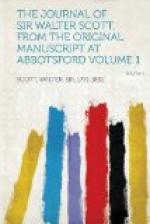FOOTNOTES:
[158] For an account of this monument see Nicolson and Burns’s History of Westmoreland and Cumberland, vol. ii. p. 410, and “Notabilia of Penrith,” by George Watson, C. and W. Transactions, No. xiv.
[159] Lady Eleanor Butler and the Hon. Miss Ponsonby. An amusing account of Sir Walter’s visit to them in 1825 is given by Mr. Lockhart in the Life, vol. viii. pp. 47-50.
[160] The visit to Kenilworth in 1815 is not noticed in the Life, but as Scott was in London for some weeks in the spring of that year he may have gone there on his return journey. Mr. Charles Knight, writing in 1842, says that Mr. Bonnington, the venerable occupant of the Gate House, told him that he remembered the visit and the visitor! It was “about twenty-five years ago”—and after examining some carving in the interior of the Gate House and putting many suggestive questions, the middle-aged active stranger slightly lame, and with keen grey eye, passed through the court and remained among the ruins silent and alone for about two hours. (Shakspeare, vol. i. p. 89.) The famous romance did not appear until six years later, viz. in January 1821, and in the autumn of that year it is somewhat singular to find that Scott and his friend Mr. Stewart Rose are at Stratford-on-Avon writing their names on the wall of Shakespeare’s birthplace—and yet leaving Kenilworth unvisited.—Perhaps the reason was that Mr. Stewart Rose was not in the secret of the authorship of the Novels.
[161] In the Annual Register for July 1834 is the following notice: “Lately at Warwick Castle, aged ninety-three, Mrs. Home, for upwards of seventy years a servant of the Warwick family. She had the privilege of showing the Castle, by which she realised upwards of L30,000.”
[162] Merry Wives, Act I. Sc. 1.
[163] As You Like It, Act II. Sc. 7.
[164] Sir Walter remained at this time six weeks in London. His eldest son’s regiment was stationed at Hampton Court; his second son had recently taken his desk at the Foreign Office, and was living at his sister’s in Regent’s Park. He had thus looked forward to a happy meeting with all his family—but he encountered scenes of sickness and distress.—Life, vol. ix. pp. 226-7.
[165] The book was published early in April under the following title: Chronicles of the Canongate, Second Series, by the Author of Waverley, etc., “SIC ITUR AD ASTRA” Motto of Canongate Arms, in three volumes. (St. Valentine’s Day; or The Fair Maid of Perth.) Edinburgh: Printed for Cadell and Co., Edinburgh, and Simpkin and Marshall, London, 1828; (at the end) Edinburgh: Printed by Ballantyne and Co.
[166] Among the “objects that came and departed like shadows” in this phantasmagoria of London life was a deeply interesting letter from Thomas Carlyle, and but for the fact that it bears Sir Walter’s London address, and the post-mark of this day, one could not imagine he had ever seen it, as it remained unacknowledged and unnoticed in either Journal or Correspondence.




